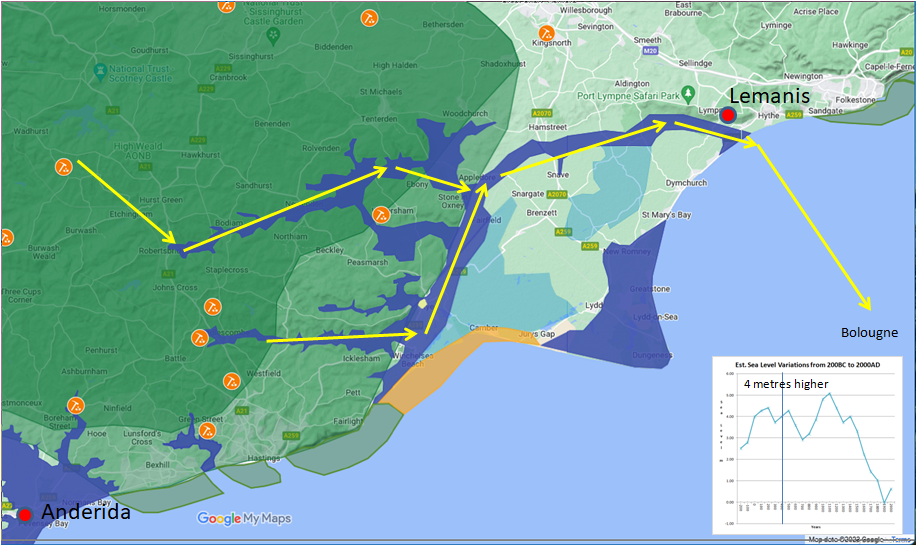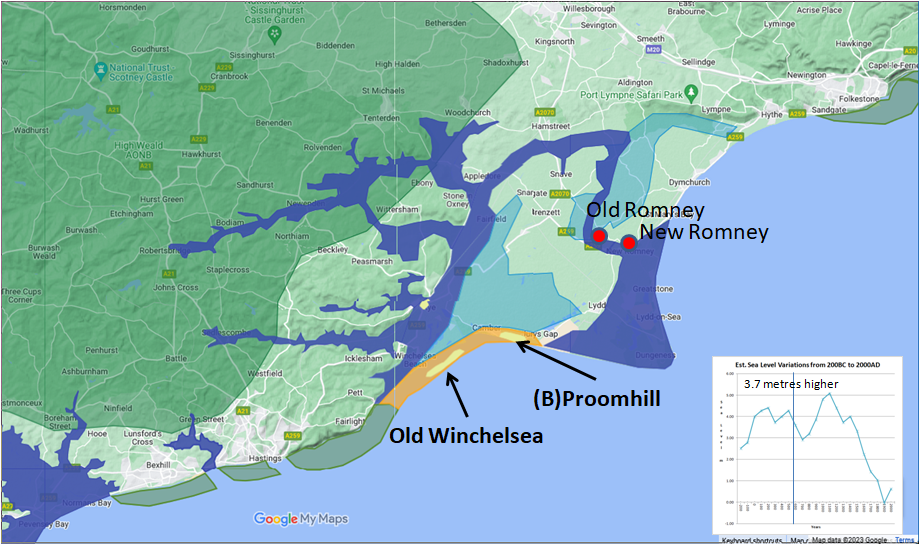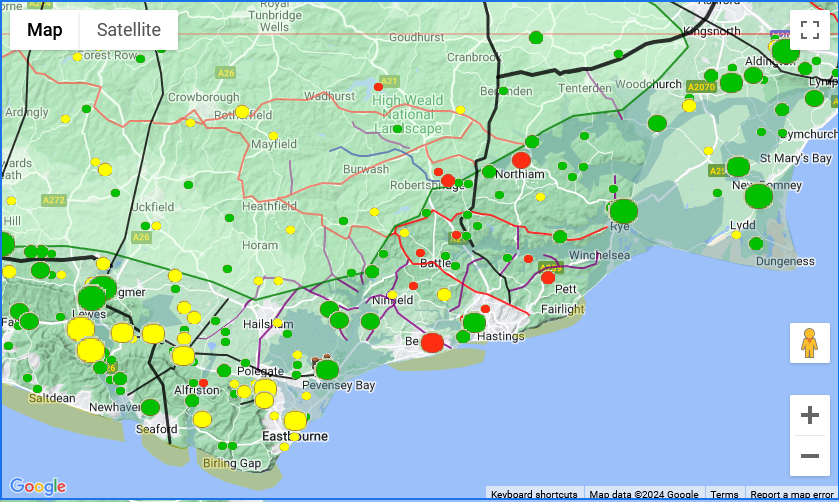|
 | Anglo Saxon History |  | |
| | Battle of Hastings 1066AD - C - Why Hastings? |
|---|
|
The area between Eastbourne and New Romney was vitally important to the Romans, the Vikings, the Saxons and the Normans
as it was the area where the The Great
Forest of Andredsweald - Anglo Saxon Chronicles reached the sea in protected inlets.
| | |
|---|
The Romans ▲
|
|---|
 The Romans occupied the area of East Sussex and West Kent as a military zone, this was due to the rich iron deposits in
the area, and the proximity of the oak forest of Andredsweald to the coast and the easy to navigate waterways.
The Romans occupied the area of East Sussex and West Kent as a military zone, this was due to the rich iron deposits in
the area, and the proximity of the oak forest of Andredsweald to the coast and the easy to navigate waterways.
Carausius built the massive shore forts at Portus Lemanis and Anderida at Pevensey to protect the area from the main
Roman Empire.
Portus Lemanis was important because the main iron production in the Rother and Brede valleys reached the sea at modern
Hythe at the time (Landscape - The History of the Romney
Marsh in maps(Pre-Roman to Modern times)).
Anderida, the fort at Pevensey was built because the main Classis Britannica base at Boulogne was taken in 296AD and it
is believed that the Pevensey area especially the area near Ashburnham was a main fleet shipbuilding area, along with
the Aspen valley at Hastings. This was due to the availability of high quality oak close to the coast, and the abundance
of iron to produce nails for the construction of ships.
| | |
|---|
The Saxons ▲
|
|---|
The Saxons settled the Kingdom of Hastings about 460AD and took over the Roman shipbuilding area in this part of East
Sussex. The area was very isolated from other parts of the South East as there were only two main road routes into the
area, a ridgeway from the Roman London to Lewes road at Crowborough and the old Roman military road from Gravesend to
the main iron works near Sedlescombe.
Hastings retained its independence until King Offa of Mercia took the kingdom in 771AD. For the kingdom to remain
independent for 311 years it implies a degree of protection and isolation. The only way this could occur is if the area
was fairly wealthy and able to afford a strong military presence.
This wealth could have been provided by sales of ships and timber from Andredweald and possibly iron but this is less
likely, however the later Medieval iron production could have destroyed the evidence of Saxon iron production.
It is very likely that a storm in 566AD rerouted the river Limen(Rother) so that its mouth changed from Hythe which was
under control by the Jutes in Kent, to Old Romney which was most likely controlled by the Haestingas.
| | |
|---|
The Vikings ▲
|
|---|

Anglo Saxon Chronicles:
A.D. 893. This year went the large army, that we before spoke about, back from the eastern district westward to
Bologne; and there were shipped; so that they transported themselves over at one time with their horses withal. And they
came up with two hundred and fifty ships into the mouth of the Limne, which is in East-Kent, at the east end of the vast
wood that we call Andred. This wood is in length, east and west, one hundred and twenty miles, or longer, and thirty
miles broad. The river that we before spoke about lieth out of the weald. On this river they towed up their ships as far
as the weald, four miles from the mouth outwards; and there destroyed a fort within the fen, whereon sat a few churls,
and which was hastily wrought.
A.D. 894.When the king heard that, then went he west towards Exeter with all his force, except a very considerable
part of the eastern army, who advanced till they came to London; and there being joined by the citizens and the
reinforcements that came from the west, they went east to Barnfleet. Hasten was there with his gang, who before were
stationed at Milton, and also the main army had come thither, that sat before in the mouth of the Limne at Appledore.
Hasten had formerly constructed that work at Barnfleet, and was then gone out on plunder, the main army being at
home.
The main Viking army appears to have remained at Appledore (in the area protected from the weather behind the Isle of
Oxney) for an extended period of time, perhaps this was to rebuild and make new ships from the Wealden Oak that lay
alongside the Rother, as there was not much else around the area at the time except saltmarsh and woodland.
The main Saxon settlement was at Old Romney, with the Langport at New Romney at the time, so the Viking fleet must have
passed these villages, and probably killed all or were welcomed by the locals. (Landscape - The History of the Romney Marsh in maps(Pre-Roman
to Modern times))
| | |
|---|
The Normans ▲
|
|---|
 The map above shows the Domesday villages that were destroyed in red, damaged in yellow and not effected in green, the
relative sizes show the population of the villages.
The map above shows the Domesday villages that were destroyed in red, damaged in yellow and not effected in green, the
relative sizes show the population of the villages.
Orderic Vitalis provides the first quote of the Norman landing
The Norman expedition, therefore, crossed the sea on the night of the third of the calends of October [29th
September], which the Catholic church observes as the feast of St. Michael the archangel, and, meeting with no
resistance, and landing safely on the coast of England, took possession of Pevensey and Hastings, the
defense of which was entrusted to a chosen body of soldiers, as a base for the Army and shelter for the Fleet.
So the Normans took control of Pevensey Castle and probably the old Burh of Hastings at Baldslow Down and installed
trusted troops to defend these strategic forts. They encountered no resistance so its possible the local Saxons invited
the Normans into the area.
Master Wace and the Norman landing
The ships steered to one port; all arrived and reached the shore together ; together cast anchor, and ran on
dry land ; and together they discharged themselves. They arrived near Hastings, and there each ship ranged by the
other's side, and they scoured the whole shore, but found not an armed man there.
The first day they held their course along the sea-shore and on the morrow came to a castle called Penevesel.
So the Normans landed near Hastings, so again probably near Bexhill and the following day took Pevensey castle. They
encountered no resistance so this record also implies that the local Saxons invited the Normans into the area.
Carmen de Triumpho Normannico and the landing
The third hour of the day overspread the earth
Since leaving the sea behind when you seize a sheltered strand
The land belonging to you had been stripped of tenants
You rejoice as you and yours seize a peaceful arc of strand
You secure the bridgehead fearing to neglect the ships
And raise palisades, that you may site the camp within
You restore the forts that were long since destroyed
You station garrisons that they may be defended
This report shows that they landed in a protected bay. They restored the Forts, Pevensey and the Hastings Burh, and
station troops there to protect them.
All the above report that the Normans took Pevensey and the Fort at Hastings, and landed on the coast possibly in a
protected inlet. The major damage to the villages appears to stem from the Bexhill area , with a lot of damaged villages
stemming from Pevensey, so probably from foraging by cavalry.
|
Conclusion ▲
|
|---|
So we have an area that is rich in iron ore and has been exploited from before Roman times to make nails and other iron
implements, and has a plentiful supply of oak trees to make ships (The Great Forest of Andredsweald - Anglo Saxon
Chronicles).
The early Britons were exporting iron to the continent, and this probably in turn attracted the Roman conquest to
exploit this for weapon manufacture. The Romans were here for about 350 years and built Pevensey and Portus
Lemanis(Stutfall) Castles to defend their iron exports and their shipbuilding. The iron production appeared to drop
significantly (see Wealden Iron Research Group) after Caurausius and Allectus were killed and the Roman Empire retook
Britannia, but the shipbuilding must have continued due to the proximity of the oak forest to the ocean.
The Saxons took over the area probably about 460AD between the landings of Henghest and Horsa and the South Saxons of
Aelle. This was probably to take over the old Roman shipbuilding areas in the Filsham and Ashbourne valleys.
The Vikings Great Army stayed at Appledore for some time in 893AD the most likely reason was to build more ships on the
Rother as there was nothing else for them in this area and it was away from the main ports at Hythe and Hastings.
The Vikings moved north and Alfred the Great built a Burh(fort) at Hastings most likely at Baldslow Down(Harrow Playing
Fields) due to the etymology and location.
The Normans then invaded the Hastings area and re-fortified the Burh and Pevensey Castle.
So this is now conjecture, but its recorded that the area was a major shipbuilding area from the
1200's to the 1500's, it would also seem likely that the area was a major shipbuilding area from Roman times as well.
If William invades and wants to get Harold's attention what better way than to take some of the major Saxon shipyards.
Williams troops contained many cavalry troop that were not really suitable for fighting in wooded areas. These cavalry
would have been better utilised in battles on the flat farmlands of Kent, so why else come to this area.
|
|
|
|
|
|
| |
|
|
Local Interest
Just click an image |
|
|
|
|
|
|
|
|
|
|
|
|
| |
|
|